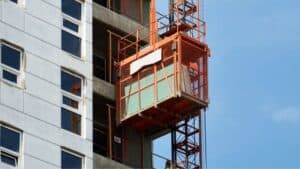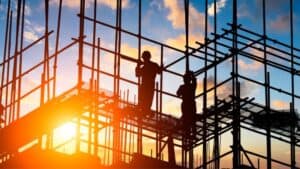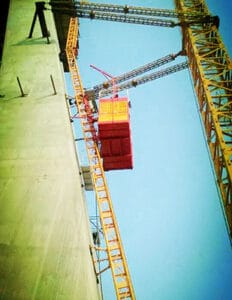As the construction industry continues to grow and evolve in 2024, understanding the factors that influence construction hoist elevator prices is crucial for effective project planning and budgeting. This comprehensive guide will explore the key considerations when selecting construction hoists.
Whether you’re a contractor, project manager, or site supervisor, this guide will provide valuable insights to help you navigate the construction hoist elevator market.
What is Construction Hoist Elevators

Construction hoist elevators, also known as buck hoists or temporary personnel and material hoists, are vertical transportation systems used to efficiently move workers, equipment, and materials to different levels of a building under construction. They play a critical role in high-rise construction projects.
Construction hoists are erected on-site for the duration of the construction project. They are set up with the aid of a tower crane and can be dismantled and moved to another location when no longer needed.
The main components include:
- Mast (Guide Rail Bracket)
- Cage
- Underframe and Protection Fence
- Wall Ties and Cable Guide Systems
- Drive System and Electrical Components
Types of Construction Hoists
Material Hoists: These are designed to move heavy building materials between floors. They don’t typically carry personnel. You can find them on sites where bulky items like steel beams, concrete blocks, and bricks need to be transported quickly.
Personnel Hoists: These are built to transport workers and lighter tools safely. They have safety features like emergency brakes and backup power systems. Personnel hoists are crucial for ensuring that workers can access various building levels without delays.
Dual-Purpose Hoists: These combine the features of material and personnel hoists. They handle both tasks effectively, which can save space and reduce costs. They tend to be more versatile and are suited for mixed-use scenarios on project sites.
What Factors Influence Your Construction Hoist Cost?
The main factors affecting construction hoist prices are the type and size of the hoist, the height and number of stops it serves, any customizations, the brand reputation, installation complexity, and long-term maintenance needs.
Type and size of the hoist
The type of hoist (e.g. goods hoist, passenger hoist) and its capacity have a significant impact on price. Higher load capacities require larger, stronger rack-and-pinion components to safely handle heavier loads.
This factor increase material costs and overall expenses, as more robust gears, racks, and additional components are necessary to meet the specific requirements of each project.
Lift height
The vertical distance of the hoist directly influences the price.
Longer travel distances require more materials, engineering, and installation time, driving up costs. For example, a hoist that needs to reach 20 stories will cost more than one that only goes up 5 stories.
Installation complexity
The complexity of installing the hoist based on the construction site conditions and building structure impacts price. Difficult access, special permits, or additional equipment rentals drive up installation costs.
Installing a hoist on an urban high-rise with limited access will cost more than an open suburban job site. Putting a hoist on the outside of an existing building is more involved than new construction installation, so it will also be more expensive.
Additional Features and Accessories
Some models have dual-car systems, which are more expensive. These allow you to move people and materials separately, increasing productivity in high-rise buildings. There are also automatic controls for smoother operation and variable frequency drives for precise speed control.
Some hoists use variable frequency drives. These allow for better speed control and energy efficiency, which are crucial for high-rise construction.
Maintenance and service
The anticipated maintenance needs and any long-term service contracts should be factored into the total cost of ownership beyond just the purchase price. Hoists in demanding environments may require more frequent and expensive maintenance.
Purchasing an extended warranty and service contract adds to the total price but provides better support.
How to Choose the Right Construction Hoist for Your Project?
Type and size of the hoist
Determine if you need a material-only hoist, a personnel hoist, or a combined personnel and material hoist based on your project requirements, and consider the load capacity and size of the hoist platform needed to transport your materials and workers efficiently.
Lift height and speed
Assess the vertical distance the hoist needs to travel. Taller buildings will require larger, higher-capacity hoists.
Power supply
Electric hoists come in single-phase for lighter loads and three-phase for heavier loads.
- Single-phase electric hoiststypically operate on 120V or 240V power and are suitable for lighter loads up to around 500kg. They are commonly used in workshops, garages, and light manufacturing.Manufacturers from China rarely provide single-phase hoist, if you have customized needs, you can consult with us.
- Three-phase electric hoistsoperate on 380V, 460V, or 575V power and can handle much heavier loads, usually 1 or 2 tons, sometimes 2.7 tons or 3.2 tons, seldom up to 5 tons. 460V is the most common in the US, while 380V is frequently offered in China and 575V is in Canada.
Pneumatic hoists are an option for hazardous environments.
Air-powered hoists don’t have any electrical components, making them suitable for hazardous environments where flammable gases, vapors, or dust are present. They require a compressed air supply of sufficient volume and pressure to operate reliably.
This is typically 90 psi at 50-200 cfm, depending on hoist size.
Job site conditions
Consider jobsite-specific factors like ground conditions, weather exposure, obstacles, and access when selecting the hoist.
If you’re working on a high-rise construction project in a dense urban area. The job site is tight on space with limited access to large equipment. The ground conditions are also less than ideal, with uneven terrain and some soft soil areas. Additionally, the project will span multiple seasons, so the hoist will be exposed to varying weather conditions like rain, wind, and possibly even snow.
In this scenario, you would need to select a hoist that can fit within the confined space of the job site and be maneuvered into position without too much difficulty. Allow for tie-ins to the building structure at appropriate intervals to ensure stability as the tower grows taller, taking into account limited access to the crowded site. The hoist may require special anchoring systems or more frequent tie-ins to accommodate the site conditions.
Furthermore, the hoist should have weatherproofing features like galvanized or stainless steel components, sealed electrical systems, and adequate lubrication to prevent rust and corrosion.
In contrast, if the project was a low-rise building on an open suburban site with firm, level ground and the hoist was only needed for a short duration in mild weather, the job site conditions would be much less of a constraint on hoist selection. A larger, less weather-resistant hoist could potentially be used without issue in that case.
Why Choose IHURMO
As a global leader in construction hoist equipment, Beijing IHURMO Industry Co., Ltd. is committed to providing top-quality vertical transportation solutions for projects worldwide. With a presence in over 100 countries and a dedication to meeting the highest international standards, IHURMO is your reliable partner for safe, efficient, and innovative construction hoists.
When you choose IHURMO, you’re not just getting a piece of machinery – you’re gaining a comprehensive solution tailored to your specific project needs. Our equipment holds both CE and EAC certifications, ensuring compliance with international regulations and giving you peace of mind on your job site.
IHURMO’s construction hoists offer a range of advantages designed to enhance safety, convenience, efficiency, maintainability, flexibility, and durability:
- Safety First:Our hoists feature escape hatches, security doors, interlocks, and guardrails to prevent accidents and protect your workers.
- Convenient Operation:Self-service hydraulics, flexible connections, aviation plugs, and ergonomic handles and lighting make our hoists easy and comfortable to use.
- Efficient Performance:Self-refueling systems, optimized outer door interlocks, and inspection mast sections streamline your operations and maximize productivity.
- Easy Troubleshooting and Maintenance:Control panels with displays, LED lighting, and access provisions simplify diagnostics and upkeep.
- Flexible Functionality:Dual side hanger rod seats and movable escape hatches allow for adaptable configurations to suit your job site layout.
Frequently Asked Questions
Construction hoist elevators can be expensive and have many different factors that affect their cost. Below are some common questions and answers to help you understand what you might expect when considering a purchase.
How much does a new construction hoist elevator typically cost?
A new construction hoist elevator can cost anywhere from $20,000 to $40,000 in Ihurmo. The price varies based on the model, size, and features.
Are there any additional costs associated with the construction hoist elevators?
Yes, there can be extra costs for installation, site preparation, and maintenance. You may also incur costs for inspections and permits, depending on local regulations.
How can I find trustworthy sellers of construction hoists?
To find trustworthy sellers of construction hoists, start by researching reputable companies with a strong industry presence and checking their certifications and accreditations. Evaluate their product range, quality, and safety focus, ensuring they offer comprehensive customer support and services. IHURMO is a verified supplier and trustworthy manufacturer in China; if you are considering buying lifting equipment, please contact us.






